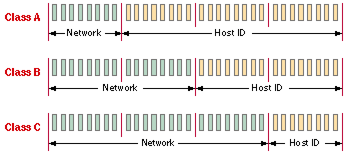IP (Internet Protocol)
The Internet Protocol, or IP, is part of the Transmission Control Protocol/Internet Protocol (TCP/IP) protocol suite. IP is a routing protocol that determines the best route or path for information to travel between stations (PC workstations, file servers, or routers). Setting up and understanding IP routing can be easy for small, less-complex networks or complicated for large, dissimilar networks. The key to understanding IP routing is to understand its most complex and flexible component--IP addressing.
Understanding IP addressing
IP addressing is a way to identify stations or hosts on a network. An IP address is a unique 32-bit number that uses a format of 4 bytes, divided into four 8-bit parts, with each byte separated by a decimal point (called dotted decimal notation). Each byte can be a number from 1 to 255. For example, 131.9.1.2 is a valid IP address. By having unique addresses on a network, you can identify individual stations (also call hosts or nodes) on the single network.
An IP address consists of two parts - one part identifies the network, and one part identifies the host (or node). Nodes define connected devices on a network, network users, and PCs.
You can assign IP addresses inside private companies using arbitrary addresses. But if you want to connect to the internet, you must use registered IP addresses that conform to an international standard. IP addresses are assigned by the InterNIC registration service. IP addresses are implemented in the network by software; they are not assigned to equipment at the factory as are Ethernet and token ring adapter addresses.
There are five types of IP addresses. Three are associated with networks -- Class A, B, and C. The illustration above shows the differences in byte assignments for networks and hosts between the three address classes. Class B and Class C addresses have fewer host ID bytes and more network bytes than Class A. The more network address, the less hosts or nodes. Class A networks have more addresses for a single network than Class B or C.
- * Class A addresses are for networks that have a large number of hosts, up to a maximum of 16, 777, 216 on a single IP network. The first octet (that is the first 4 bytes, or the first segment before a decimal) is between 1 and 126. (127 is reserved for loopback and is used for internal testing on the local machine.)
- * Class B addresses are for medium-sized networks. The first octet is between 128 and 191.
- * Class C addresses are for small networks, with up to 255 hosts. The first octet is between 192 and 223.
- * Class D addresses are reserved for multicasting and the first octet is between 224 and 239.
- * Class E addresses (240 to 255) are reserved and should not be used.

